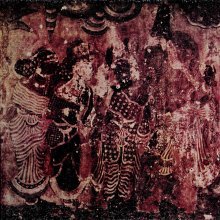Atibhanga, Atibhaṅga: 2 definitions
Introduction:
Atibhanga means something in Hinduism, Sanskrit. If you want to know the exact meaning, history, etymology or English translation of this term then check out the descriptions on this page. Add your comment or reference to a book if you want to contribute to this summary article.
Images (photo gallery)
In Hinduism
Shilpashastra (iconography)
Source: Shodhganga: The significance of the mūla-beras (śilpa)Atibhaṅga (अतिभङ्ग) refers to one of the three types of bhaṅga (“inflexions of the body”) which is one of the three divisions of pratimālakṣaṇa (body postures of the icons), as defined according to texts dealing with śilpa (arts and crafs), known as śilpaśāstras.—The bend in the body of an icon is called bhaṅga (flexions or attitudes). Atibhaṅga is the form of the tribhaṅga curve being considerably enhanced. The bhaṅgas play a vital role in the postures of the deities and also while depicting them in dance. [...] The atibhaṅga and the abhaṅga postures are found in dance practice, but there is no exact term given for these postures in dance.

Shilpashastra (शिल्पशास्त्र, śilpaśāstra) represents the ancient Indian science (shastra) of creative arts (shilpa) such as sculpture, iconography and painting. Closely related to Vastushastra (architecture), they often share the same literature.
Languages of India and abroad
Sanskrit dictionary
Source: DDSA: The practical Sanskrit-English dictionaryAtibhaṅga (अतिभङ्ग).—A pose in which the idol is bent in more than two or three places; आभङ्गं समभङ्गं च अतिभङ्गं त्रिधा भवेत् (ābhaṅgaṃ samabhaṅgaṃ ca atibhaṅgaṃ tridhā bhavet) | Māna.67.95-96.
Derivable forms: atibhaṅgam (अतिभङ्गम्).
Sanskrit, also spelled संस्कृतम् (saṃskṛtam), is an ancient language of India commonly seen as the grandmother of the Indo-European language family (even English!). Closely allied with Prakrit and Pali, Sanskrit is more exhaustive in both grammar and terms and has the most extensive collection of literature in the world, greatly surpassing its sister-languages Greek and Latin.
See also (Relevant definitions)
Ends with: Aratibhanga, Gatibhanga, Ratibhanga, Yatibhamga.
Full-text: Abhanga, Valli, Bhanga, Minakshi, Sthitakuncita, Deivanai, Govardanambikai, Antal, Muthukumara, Durga.
Relevant text
Search found 6 books and stories containing Atibhanga, Atibhaṅga; (plurals include: Atibhangas, Atibhaṅgas). You can also click to the full overview containing English textual excerpts. Below are direct links for the most relevant articles:
Indian Sculpture: Orissa's Role < [April 1957]
Indian Sculpture: Orissa's Role < [April 1957]
Gati in Theory and Practice (by Dr. Sujatha Mohan)
Gati in classical form of Mohiniāṭṭam < [Chapter 4 - Practice of Gati]
Manasara (English translation) (by Prasanna Kumar Acharya)
Later Chola Temples (by S. R. Balasubrahmanyam)
Temples in Valuvur < [Chapter XII - Temples of Kulottunga III’s Time]
The Religion and Philosophy of Tevaram (Thevaram) (by M. A. Dorai Rangaswamy)
Chapter 3.6 - Kalasamhara-murti (Markandeya and the conquest of death) < [Volume 2 - Nampi Arurar and Mythology]
Chapter 3.1 - Tripurantaka-murti (burning down of the three castles) < [Volume 2 - Nampi Arurar and Mythology]
Stupas in Orissa (Study) (by Meenakshi Chauley)
Minor Votive Stupas at Langudi < [Chapter 4]
